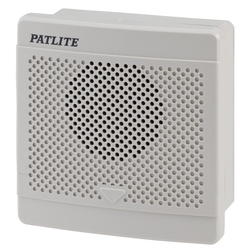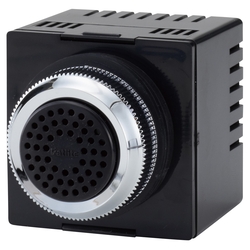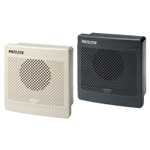(!)NOTE : Windows 7 users won’t be able to use some latest features of eCatalog/WOS since Microsoft is ending support for Windows 7 on 14 Jan, 2020. Please upgrade your system for uninterrupted services.
- Notice of End of Sales for Economy Series Pneumatic Equipment Category. More information.
PATLITE Alarms/Buzzers(Rated Voltage:AC100V)
Brand |
|
|---|---|
| CAD |
|
| Days to Ship |
|
3 items
- Sort By
-
You can add up to 6 items per a category to the compare list.

PATLITE
The BK1 unit features 32 built-in tones. An embedded type with clear audio quality.
[Features]
· Easy to operate using the switch volume card slots on the front side.
· The volume can be adjusted on the front surface of the main body.
· Installing the switches, which were hitherto on the back of the main body, on the front panel enables operations from the installation side, improving operability.
· A dedicated embedded type.
· An IP54 structure (only on front with front-facing panel mounted).
· Produces a high volume sound of 95dB (at1m) despite its relatively compact size.
· Furthermore, the volume can be adjusted using the knob on the front of the main body.
· Features compatibility with NPN transistor open collectors, enabling direct drive with a PLC etc
· Compliant with CE standards.
· Compliant with international standards, allowing it to be used globally (24V specifications).
· A two-color front panel is available for use with embedded equipment.
· The tone group selection switch allows for switching between the 32 available sounds as needed.
· Settings A to H and the bit input method enable playback of eight different tones.
· Settings I to O enable test sound (ambulance siren) playback.
· Can be used to check operations and adjust the volume.
· The P setting and the binary input method enable 32-tone playback.
· Tone combinations can be changed as needed with the SD card- CAD :
- 2D
Volume(dB) Product Type Rated Voltage(V) Shape Sound Types of sound Volume adjustment Terminal shape Dimension width(mm) Protection function (IP/drip-proof, etc.) Representative Standard Dimension length(mm) Dimension thickness(mm) 95 - AC100V Square shape Continuous Voice/music Available - 120 Available - 120 62.8 From: ₹ 17,243.76 Days to Ship: 5 Day(s) or more  5 Day(s) or more
5 Day(s) or more
-
You can add up to 6 items per a category to the compare list.

PATLITE
Ultra compact electronic buzzer with 2 built-in tones. Ideal for embedding into equipment.
[Features]
· Two easily distinguishable built-in tones suitable for emergency alarms.
· Compatible with NPN/PNP transistor open collectors, enabling direct drive on PLC, etc. (24 V specification).
· Small and lightweight type product with a ø30 mm front surface, 42 mm depth and 100 g weight.
· Dedicated embedded type product for indoors that can be mounted on panels with a thickness of 7 mm or less.
· Drip-proof structure (IP34) enables use in factories with heavy moisture or powder dust as well as outdoors (BM-D type).
· Operated using the ON/OFF switch on the power supply.
· If there are 2 simultaneous input signals, Channel 1 is given priority (rapid, alternating two-tone sound).
[Applications]
· Embeddable into control panels and devices.- CAD :
- 2D
Volume(dB) Product Type Rated Voltage(V) Shape Sound Types of sound Volume adjustment Terminal shape Dimension width(mm) Protection function (IP/drip-proof, etc.) Representative Standard Dimension length(mm) Dimension thickness(mm) 80 ~ 90 - AC100V Square shape Continuous / Intermittent Voice/music / Other NA - 50 Available - 50 64 From: ₹ 3,702.44 Days to Ship: 5 Day(s) or more  5 Day(s) or more
5 Day(s) or more
-
You can add up to 6 items per a category to the compare list.

MP3 sound synthesis alarm BKV for board
PATLITE
A high-quality synthetic audio alarm that uses MP3 format audio. Produces a large volume of 95 dB (at 1 m). No sound sources (MP3 data) included. Please prepare separately.
[Features]
· A dedicated embedded type.
· Can output a maximum volume of 95dB (at 1 m) despite its compact size.
· The volume can be adjusted using the knob on the front of the main body.
· The messages can be changed while installed using an SD card.
· The various playback modes enable settings suited to different applications.
· Compatible with NPN transistor open collectors.
· Complies with EC directives. CE marking compliant.
· Two-color types are available for use with embedded equipment.
· An IP54 protection grade structure (front with forward mounting only).- CAD :
- 2D
Volume(dB) Product Type Rated Voltage(V) Shape Sound Types of sound Volume adjustment Terminal shape Dimension width(mm) Protection function (IP/drip-proof, etc.) Representative Standard Dimension length(mm) Dimension thickness(mm) 95 - AC100V Square shape Continuous / Intermittent Voice/music / Other Available - 120 Available - 120 62.8 From: ₹ 29,933.18 Days to Ship: 5 Day(s) or more  5 Day(s) or more
5 Day(s) or more
| Brand |
|---|
| Product Series |
| CAD |
| From |
| Days to Ship |
| Volume(dB) |
| Product Type |
| Rated Voltage(V) |
| Shape |
| Sound |
| Types of sound |
| Volume adjustment |
| Terminal shape |
| Dimension width(mm) |
| Protection function (IP/drip-proof, etc.) |
| Representative Standard |
| Dimension length(mm) |
| Dimension thickness(mm) |
You can add up to 6 items per a category to the compare list. | You can add up to 6 items per a category to the compare list. | You can add up to 6 items per a category to the compare list. | |
| Brand | PATLITE | PATLITE | PATLITE |
| Product Series | |||
| CAD |
|
|
|
| From | ₹ 17,243.76- | ₹ 3,702.44- | ₹ 29,933.18- |
| Days to Ship | 5 Day(s) or more | 5 Day(s) or more | 5 Day(s) or more |
| Volume(dB) | 95 | 80 ~ 90 | 95 |
| Product Type | - | - | - |
| Rated Voltage(V) | AC100V | AC100V | AC100V |
| Shape | Square shape | Square shape | Square shape |
| Sound | Continuous | Continuous / Intermittent | Continuous / Intermittent |
| Types of sound | Voice/music | Voice/music / Other | Voice/music / Other |
| Volume adjustment | Available | NA | Available |
| Terminal shape | - | - | - |
| Dimension width(mm) | 120 | 50 | 120 |
| Protection function (IP/drip-proof, etc.) | Available | Available | Available |
| Representative Standard | - | - | - |
| Dimension length(mm) | 120 | 50 | 120 |
| Dimension thickness(mm) | 62.8 | 64 | 62.8 |
Loading...
Configure
Specification/Dimensions
-
Volume(dB)
-
Product Type
- Alarm / Buzzer Unit
- Other
-
Rated Voltage(V)
- DC24V
- AC100V
- Other
-
Shape
-
Sound
- Continuous
- Intermittent
-
Types of sound
- Peak
- Boost
- Voice/music
- Other
-
Volume adjustment
- Available
- NA
-
Terminal shape
- Solder terminal
- Screw terminal
- Other
-
Dimension width(mm)
-
Protection function (IP/drip-proof, etc.)
-
Representative Standard
-
Dimension length(mm)
-
Dimension thickness(mm)
Narrow search by specifying Manufacturer
-
- PATLITE (3)
- OMRON (1)
- D.S.TECHNOLOGY (0)
- MIRAI INDUSTRY (0)
Related Categories to Alarms/Buzzers
FAQ Alarms/Buzzers
- Question: How do buzzers function in electrical circuits?
- Answer: Electromagnetic buzzers use an electromagnetic coil to generate a magnetic field. This field attracts a movable diaphragm, causing mechanical vibrations. As the diaphragm moves back and forth, it produces sound waves, resulting in the audible buzzing or beeping sound. Connected to an electrical circuit, the buzzer is activated when current flows through the coil. It's important to note that there are different types of buzzers, including electromagnetic, piezoelectric, and magnetic-transducer buzzers. Each type operates on different principles
- Question: What are the typical uses of buzzers in various industries?
- Answer: Buzzers are widely used in various industries for signaling and alerting. Here are some typical uses of buzzers in different industries such as:
1. Automotive industries: In vehicles, buzzers are employed for warning signals, such as seatbelt reminders, and low fuel indicators.
2. Medical Industries: Medical devices use buzzers for alarms and notifications, such as indicating the end of a medical procedure or alerting healthcare professionals to specific conditions.
3. Industrial Automation: Buzzers are used in manufacturing and industrial settings to signal the completion of processes, indicate faults, or alert operators to specific events.
4. Security Systems Industries: Alarm systems and security devices use buzzers to produce loud alerts in the event of a breach, fire, or other security concerns. - Question: What differentiates piezo buzzers from electromagnetic buzzers?
- Answer:
This table summarizes the key differences between piezo buzzers and electromagnetic buzzers in terms of their operating principles, mechanisms, sound frequency ranges, efficiency, size, and common applications.
Feature Piezo Buzzers Electromagnetic Buzzers Operating Principle Crystal deformation Diaphragm driven by electromagnet Mechanism Crystal vibrations directly produce sound Diaphragm or armature physically moves to create sound Sound Frequency Range Narrow, often in ultrasonic or audible range Broader range, capable of various frequencies Efficiency High efficiency, fast response time Variable efficiency, may have slower response time Size and Weight Generally smaller and lighter Tends to be larger and heavier Applications Compact designs, low power, high-frequency Various applications, broader frequency requirements - Question: What factors determine the loudness of a buzzer?
- Answer: 1. Power Input: Higher electrical power results in increased loudness.
2. Design and Construction: Physical characteristics impact efficiency.
3. Resonance Frequency: Operating at resonant frequency maximizes loudness.
4. Voltage and Current: Increased levels within limits enhance sound output.
5. Environmental Conditions: Surrounding factors influence perceived loudness.
6. Transducer Efficiency: Efficient transducers produce more sound.
7. Sound Output Mechanism: Different mechanisms impact loudness.
8. Duty Cycle: Continuous operation may enhance perceived loudness.
9. Frequency Range: Some frequencies are more noticeable or louder than others. - Question: Can buzzers be considered a form of sound energy?
- Answer: Yes, buzzers can be considered a form of sound energy. Sound energy is a type of mechanical wave that propagates through a medium, such as air, water, or solids. When a buzzer is activated, it typically produces vibrations that create compressions and rarefactions in the surrounding air, generating sound waves. These sound waves carry energy in the form of vibrations, and when they reach our ears, they are perceived as sound.
- Question: How do you integrate a buzzer into a security system?
- Answer: Incorporate a buzzer into a security system by linking it to a controller, such as Arduino or Raspberry Pi. Ensure proper power alignment, connect to a digital output pin, and code the buzzer to respond to security events like unauthorized access detected by sensors.Thoroughly test and calibrate the system, considering backup power.
- Question: How do you choose the appropriate buzzer size and sound level for different environments?
- Answer: Select a buzzer size based on space constraints and application requirements. For quiet environments, opt for smaller, less powerful buzzers to minimize disturbance. In noisy settings, choose larger buzzers with higher sound levels for better audibility. Consider dB ratings to match ambient noise levels; quieter environments need lower dB, while louder surroundings require higher dB ratings. Always test in the specific environment to ensure the chosen buzzer meets the desired sound level without being excessively disruptive or inadequate for the given conditions.
- Question: What are the main considerations when connecting a buzzer to a digital circuit, such as an Arduino or Raspberry Pi?
- Answer: When buzzing with digital circuits, remember these key points:
1. Buzzer type: Choose between active (amplified, needs only digital signal) or passive (requires driver circuit).
2. Voltage and current: Match buzzer specs to your board's capabilities (e.g., 5V for Arduino). Calculate current draw and ensure sufficient power supply.
3. Driving the buzzer: Use a transistor or driver IC for passive buzzers or high current needs. Connect active buzzer directly to a digital pin.
4. Pulse frequency: Control sound pitch and pattern by varying the frequency of the digital signal driving the buzzer (typically 200Hz to 5kHz).
5. Protection: Add a flyback diode across the buzzer to absorb reverse voltage spikes generated when switching it off.














How can we improve?
How can we improve?
Thank you for your time.
Your feedback is essential for our continuous improvement
Privacy Policy
Thank you for your cooperation.
Thank you for your time.
Your feedback is essential for our continuous improvement
Please use the inquiry form.
Privacy Policy